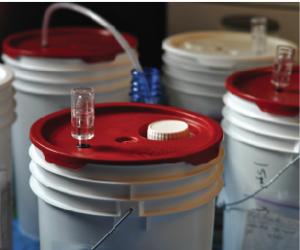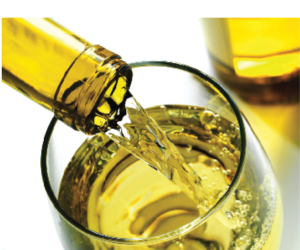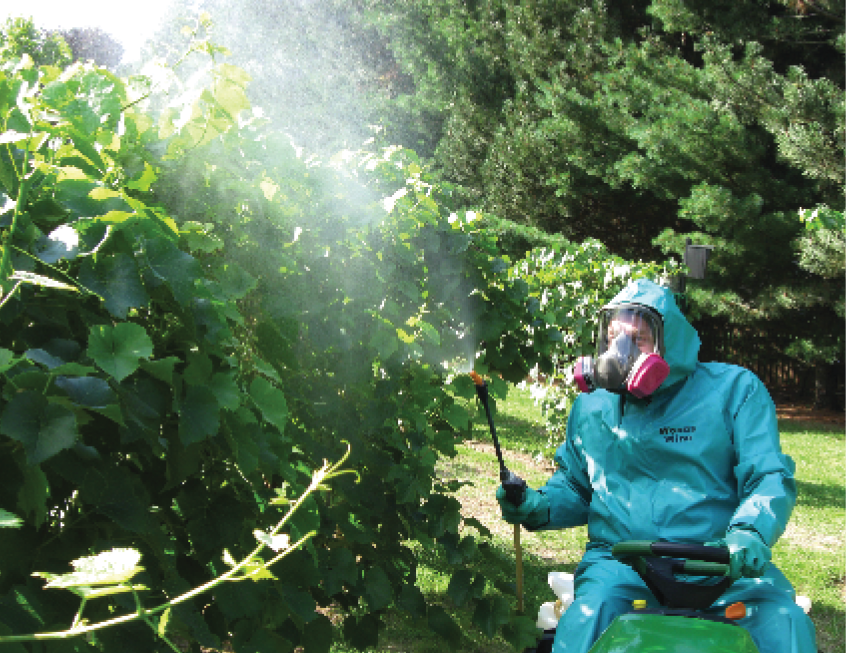 This article will provide the backyard grape grower with a pragmatic guide to the use of pesticides on a small scale. I will cover an approach to developing a spray program for your vineyard, the spraying equipment, and the calculations determining how much pesticide to apply to your vineyard.
This article will provide the backyard grape grower with a pragmatic guide to the use of pesticides on a small scale. I will cover an approach to developing a spray program for your vineyard, the spraying equipment, and the calculations determining how much pesticide to apply to your vineyard.
Developing Your Program
For the purpose of this article, pests include unwanted insects, diseases and unwanted competing plants. Deer, raccoons, and birds are also pests, but they are outside the scope of this article. Pesticides include insecticides, fungicides and herbicides. When developing a spray program for your specific vineyard, keep in mind that your pesticide requirements may not be the same as someone else’s. A spray program is designed to control the diseases and insects that your vineyard is susceptible to. Different grape cultivars have different susceptibilities to different diseases. Also be aware that there will be year to year differences in the threats that your vineyard will face, primarily depending on the weather.
Spray programs are developed by knowing which diseases and insects are likely to occur in your vineyard at specific growth stages of the grapevine. Examples of these stages are: bud swell, ½” to 1” shoots, 3” to 5” shoots, 10” to 12” shoots, pre-bloom, full bloom, buckshot berries, berry touch, and veraison. University grape pest management programs, such as those developed by UC- Davis and Cornell/Penn State, use these grapevine growth milestones.
Here are some excellent spray-related resources:
New York and Pennsylvania Pest Management Guidelines for Grapes http://ipmguidelines.org/grapes/
UC-Davis Grape Pest Management Guidelines http://www.ipm.ucdavis.edu/PMG/selectnewpest.grapes.html
Midwest Small Fruit & Grape Spray Guide
https://store.extension.iastate.edu/ProductList.aspx?Keyword=pm%201375
Michigan State University — Pest Control in Small Vineyards http://migarden.msu.edu/uploads/files/e2698.pdf
Compendium of Grape Disease http://www.apsnet.org/apsstore/shopaps press/Pages/40888.aspx
Pocket Guide for Grape IPM Scouting in the North Central and Eastern U.S. http://www.grapes.msu.edu/publications.htm
One of the best herbicide tips I can give you is how to keep the vineyard floor under your trellis bare. I have found that applying Roundup and Prowl H2O early (before bud swell) will keep the vineyard floor clear of weeds and grasses for the entire growing season. I apply both chemicals at their maximum allowable rate, and mix them both in the same tank. This has been a great way to keep the vineyard floor looking neat as a pin, and also eliminates competition for water and nutrients.
With a spray program there are pests identified at critical growth stages, and a chemical was selected to address those threats. The Restricted Entry Interval (REI) is the amount of time required before a person should enter the vineyard without Personal Protective Equipment (PPE) on. The Pre-Harvest Interval (PHI) is the number of days before your expected harvest date that you have to stop applying the product.
It is desirable to spray when the temperatures are not too hot, the wind is relatively slow, and the probability of rain is low. The National Oceanic and Atmospheric Administration (NOAA) web site can help you predict these parameters for 7 days into the future. In order to predict these parameters for your vineyard, you will need to determine the exact latitude and longitude of your vineyard.
You can obtain this information at the following web site: http://itouchmap.com/latlong.html
When you have the latitude and longitude of your vineyard, go to the following web site, enter your latitude and longitude, and get a forecast:
http://forecast.weather.gov/wxplanner.php?site=buf
 Spraying Equipment
Spraying Equipment
There are several sprayer options available to the backyard viticulturist. I originally used a backpack sprayer for the canopy, and a hand-held sprayer for the vineyard floor. I have found that a hand-held tank and a backpack sprayer are a lot more work than using a sprayer with an electric pump. I currently have two 15- gallon (57-L) electric sprayers that attach to my lawn tractor. I use one of the sprayers exclusively for canopy applications, and the other sprayer exclusively for herbicides such as Roundup being applied to the vineyard floor. For my canopy sprayer, I fashioned a mounting frame from angle iron and attached an inexpensive ATV sprayer to it. My Roundup sprayer is a John Deere stock sprayer that attaches directly to my lawn tractor. I have also fashioned a spray shield out of a Tupperware bowl that minimizes overspray and drift when applying herbicides to the vineyard floor. I have learned to keep a bucket attached to my tractor so I can put the spray shield in the bucket when moving from row to row. This will prevent the drips of herbicide from making bare lines in your lawn from row to row. I learned this information the hard way.
After you are finished spraying the vineyard, it is important to clean out the sprayer and to wash down the tractor. I completely rinse out the tank with a garden hose until the water comes out clear. I also run the clear water through the spray nozzle until the spray is also clear water. I then use a long handled brush to wash any residual spray from the tractor body. This is a good habit to get into right away and make it part of your routine every time you spray. When I spray for the last time of the season, I winterize my sprayers by using automobile windshield washer fluid.
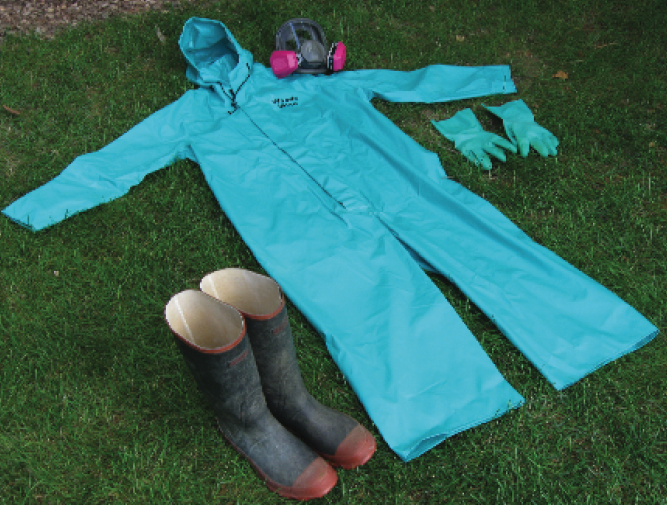 It is also important to wear the appropriate Personal Protective Equipment (PPE). Required PPE is identified on every pesticide label. Speaking of labels, they are the law and must be adhered to for such things as spray application rates, REIs, PHIs and maximum allowable applications per season. A piece of safety equipment that may not be obvious is a lockable storage cabinet for the pesticides. This is especially important if there is a chance of having inquisitive children in the proximity of the pesticides. One of the best ways you can learn what you need to know about pesticide safety is by getting your Private Pesticide Applicator Certification. The exam is not very difficult, and it costs about $100. Both the test and the certification are administered by the Department of Environmental Conservation in New York, and by similar government departments in other states. I highly recommend the training and certification; it could save your life and prevent harming other people as well.
It is also important to wear the appropriate Personal Protective Equipment (PPE). Required PPE is identified on every pesticide label. Speaking of labels, they are the law and must be adhered to for such things as spray application rates, REIs, PHIs and maximum allowable applications per season. A piece of safety equipment that may not be obvious is a lockable storage cabinet for the pesticides. This is especially important if there is a chance of having inquisitive children in the proximity of the pesticides. One of the best ways you can learn what you need to know about pesticide safety is by getting your Private Pesticide Applicator Certification. The exam is not very difficult, and it costs about $100. Both the test and the certification are administered by the Department of Environmental Conservation in New York, and by similar government departments in other states. I highly recommend the training and certification; it could save your life and prevent harming other people as well.
When I first started, I used a face mask and a Tyvek coverall without a hood. After I took the Pesticide Safety Training, I decided to get a full face respirator and a rubberized set of coveralls with a hood. It gets warm inside the suit in the middle of the summer, but I sure feel much more protected. I also use rubber gloves and rubber boots. I spray early in the morning before it gets too hot outside. Spraying early in the morning also gets the job done before the neighbors are up and about. I’m sure they would be curious when they see me spraying in my protective equipment.
Spraying Calculations
Did you ever wonder why the pesticide labels specify ounces per acre or pounds per acre in their application rates? Did you ever think how much easier it would be if they just told us what the ratio of pesticide to water is? It took me a long time to understand their logic, but it makes sense to me now. Let me give you an example of why a pesticide/water ratio doesn’t work. It’s all about how much liquid your sprayer is putting out, and how fast you are driving the tractor. Assume that I have a ratio of 1 ounce of pesticide to 15 gallons of water, and at ½ throttle, I can spray the entire vineyard with the entire 15 gallons of water. Now I use that same ratio of one ounce to 15 gallons of water, but I drive the tractor at ¼ throttle. I will run the sprayer dry after only applying the pesticide to ½ of the vineyard. Consequently the sprayed half of the vineyard received twice the desired rate of pesticide, and the second half of the vineyard didn’t receive any pesticide. The key pieces of information required are to know how much pesticide you need for the acreage that you are targeting, and how much water you will use when spraying that target acreage. When determining the amount of water to use, take into account how fast you will drive your tractor, and also how you have your sprayer nozzle set. This is what I refer to as calibrating the backyard sprayer.
When calibrating your backyard sprayers, we have two different scenarios, and hopefully two different sprayers. One scenario is spraying the vineyard floor under the trellis, and the other scenario is spraying the canopy.
Vineyard Floor (Under Trellis) Calculations
1. Using your sprayer and plain water, determine the amount of water you will need to spray target area with good coverage. If your rows are the same length, you can spray one row and multiply that amount of water by the number of vineyard rows you have.
2. Determine the square footage of the area being sprayed. Allow for 2–3 feet (60–90 cm) wide bare floor under the trellis and at end of rows.
3. Determine the acreage of the spray area in percentage of an acre. (1 acre = 43,560 sq. ft.)
4. Multiply the chemical rate per acre times the percentage of an acre that you will be spraying.
5. Add that calculated amount of chemical to the pre-determined amount of water required for good coverage.
Vineyard Canopy Calculations
1. Determine the amount of water you will need to spray target vines with good mist coverage. If your rows are the same length, you can spray one row and multiply that amount of water by the number of vineyard rows you have.
2. Determine the square footage of the area being sprayed. Allow for actual row spacing in the vineyard, and buffer at end of rows.
3. Determine the acreage of the spray area in percentage of an acre.
4. Multiply the chemical rate per acre times the percentage of an acre that you will be spraying.
5. Add that calculated amount of chemical to the pre-determined amount of water.
So now you know how large the target areas are in acres, and the amount of product that needs to be applied to those target acreages. You need to run your sprayer with plain water to determine how much water you will need to complete a sufficient spray a) on the vineyard floor, and b) on the canopy. (Remember that if your rows are the same length, you can do one or two rows and multiply.) Then put on your protective equipment, mix the appropriate amount of pesticide to the appropriate amount of water, and spray.
Under Trellis Vineyard Floor Area Calculation
•Row length needs to include about 1 ft. past the earth anchors or end posts
•Assume 3 ft. beyond end post will therefore be sprayed with herbicides
•3 ft. * (48ft. + 3ft. +3ft.) = 162 sq. ft. per row
•162sq. ft. * 6 rows = 972 sq. ft.
•972 sq. ft. = 0.0223140496 acre = ~ 0.025 acre


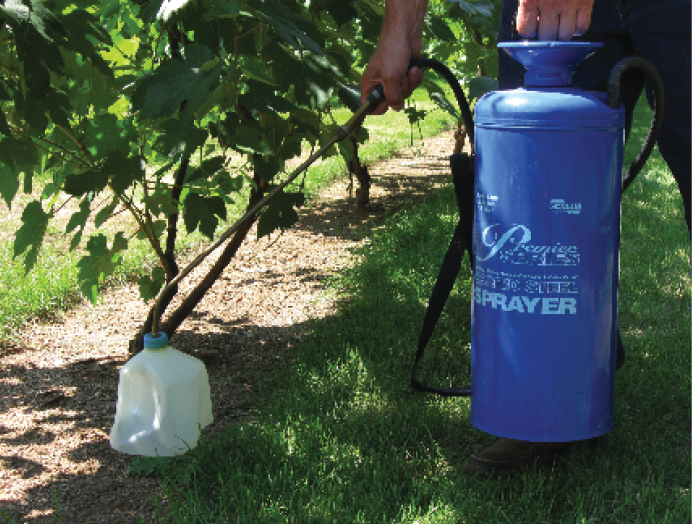 Spraying Equipment
Spraying Equipment
